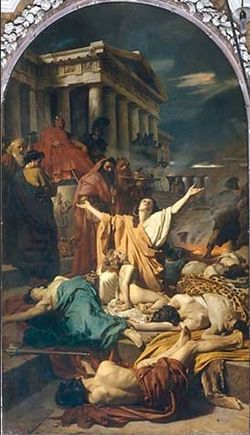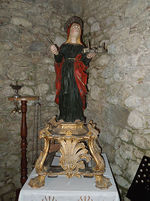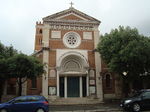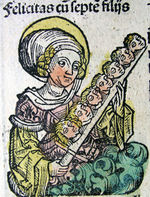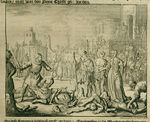Difference between revisions of "Category:Maccabean Martyrs (subject)"
| Line 44: | Line 44: | ||
[[File:Felicitas Martyrdom.jpg|thumb|150px|left|Martyrdom of Felicitas]] | [[File:Felicitas Martyrdom.jpg|thumb|150px|left|Martyrdom of Felicitas]] | ||
'''[[Felicitas of Rome]]''' | '''[[Felicitas of Rome]]''' | ||
[[Felicitas of Rome]] is said to have been a rich and pious Christian widow who had seven sons. Around 165, the Prefect of Rome used various pleas and threats in an unsuccessful attempt to get her and her sons to worship the pagan gods. First the children (Januarius, Felix, Philip, Silvanus, Alexander, Vitalis, Martialis) were martyrized; then the mother also was killed. According to tradition, Felicitas and SIlvanus were buried in the Cemetery of Maximus, on the Via Salaria, while the other children were buried in three nearby cemeteries. The crypt where St Felicitas was laid to rest was later enlarged into a subterranean chapel, and was rediscovered in 1885; some of her relics are in the Capuchin church at Montefiascone, Tuscany and in the church of Santa Susanna in Rome. One of her chidren, Martialis, is venerated as the patron saint of Torricella Peligna in the Abruzzo, and Isca sullo Ionio in Calabria, Italy. | [[Felicitas of Rome]] is said to have been a rich and pious Christian widow who had seven sons. Around 165, the Prefect of Rome used various pleas and threats in an unsuccessful attempt to get her and her sons to worship the pagan gods. First the children (Januarius, Felix, Philip, Silvanus, Alexander, Vitalis, Martialis) were martyrized; then the mother also was killed. According to tradition, Felicitas and SIlvanus were buried in the Cemetery of Maximus, on the Via Salaria, while the other children were buried in three nearby cemeteries. The crypt where St Felicitas was laid to rest was later enlarged into a subterranean chapel, and was rediscovered in 1885; some of her relics are in the Capuchin church at Montefiascone, Tuscany and in the church of Santa Susanna in Rome. One of her chidren, Martialis, is venerated as the patron saint of Torricella Peligna in the Abruzzo, and Isca sullo Ionio in Calabria, Italy. | ||
Revision as of 10:44, 5 January 2016
According to Jewish and Christian traditions, the Maccabean Martyrs were the members of a Jewish family (seven brothers and their mother) martyrized under Antiochus IV Epiphanes (2nd cent. BCE). In later Roman times, the setting of the narrative was moved to the 2nd cent. CE; the "Maccabean mother" became the Jewish martyr Miriam bat Tanhum and the Christian martyrs Symphorosa of Tibur or Felicitas of Rome.
Overview
According to 2 Maccabees 7, Antiochus IV Epiphanes arrested a mother and her seven sons, and tried to force them to eat pork. When they refused, he tortured and killed the sons one by one. The narrator ends by saying that the mother died too, without specifying whether she was executed, or died in some other way.
Although the martyrs were no relatives of the Maccabees, they became known as the Maccabean Martyrs, as they died during the time of persecution just before the Maccabean revolt.
The story is retold in 4 Maccabees (where the mother throws herself into the flames) and in Josippon (where the mother falls dead on her sons' corpses).
According to Eastern Orthodox tradition, the sons are called Abim, Antonius, Gurias, Eleazar, Eusebonus, Alimus and Marcellus, though the names differ slightly among different authorities
The three Ethiopian books of Meqabyan (canonical in the Ethiopian Orthodox Church, but distinct works from the other four books of Maccabees) refer to an unrelated group of "Maccabean Martyrs," five brothers including 'Abya, Seela, and Fentos, sons of a Benjamite named Maccabeus, who were captured and martyred for leading a guerilla war against Antiochus Epiphanes.
Relics of the Maccabean Martyrs
According to Antiochene Christian tradition, the relics of the mother and sons were interred on the site of a synagogue (later converted into a church) in the Kerateion quarter of Antioch, where they were venerated until the 6th century. After 551, they were transferred to Constantinopolis and from there to Rome under Pelagius II.
In 1876 a sarcophagus inscribed to the Maccabean martyrs was discovered in San Pietro in Vincoli in Rome, Italy. The Maccabees Shrine, also containing the relics of the martyrs, is venerated in St. Andrew Church, Cologne, Germany.
Related legends
Similar stories, concerning a mother and her 7 sons who all died martyrs, were retold both in Judaism and Christianity. They are clearly a double of the Maccabean story but the event is now chronologically located in Roman times. The "relocation" of the event allowed each community to completely Judaize or Christianize the story.
The Jewish version (Miriam bat Tanhum and her sons)
In the Rabbinic rendition of the story (b. Gittin 57b; Lamentation Rabbah 1:16, no 50; Pesikta Rabbati 43:180; Seder Eliyahu Rabbah 30:151), the refusal to worship an idol replaces refusal to eat pork and the unnamed king is referred to as the "Emperor" and "Caesar". The woman commits suicide (she "also went up on to a roof and threw herself down and was killed"). The woman generally remains unnamed, but in Lamentations Rabbah she is called Miriam bat Tanhum.
A tomb believed to be that of the woman with her seven sons is located in the Jewish cemetery of Safed.
The Christian versions (Symphorosa of Tibur and Felicitas of Rome)
There are two major Christian adaptations of the story, one connected with Saint Symphorosa of Tibur (at the time of Emperor Antoninus Pius) and the other with Saint Felicitas of Rome (at the time of Emperor Marcus Aurelius).
Symphorosa is said to have been a Tiburtine matron, the widow of the tribune Getulius, who had previously been martyred under Emperor Hadrian at Gabii (now Torri). Around 138, the new Emperor Antoninus Pius attempted to induce Symphorosa also to sacrifice to the Roman gods. As she refuses to comply, she was thrown into the river Anio with a heavy rock fastened to her neck. The next day her children (Crescens, Julian, Nemesius, Primitivus, Justinus, Stracteus, Eugenius) also were martyrized. According to tradition, the bodies of the martyrs were buried in a basilica built on via Tiburtina over their tomb and later transferred to the Church of Sant'Angelo in Pescheria at Rome by Pope Stephen II in 752, where a sarcophagus bearing their names was found in 1610. The Diocese of Tivoli honors them as patron saints.
Felicitas of Rome is said to have been a rich and pious Christian widow who had seven sons. Around 165, the Prefect of Rome used various pleas and threats in an unsuccessful attempt to get her and her sons to worship the pagan gods. First the children (Januarius, Felix, Philip, Silvanus, Alexander, Vitalis, Martialis) were martyrized; then the mother also was killed. According to tradition, Felicitas and SIlvanus were buried in the Cemetery of Maximus, on the Via Salaria, while the other children were buried in three nearby cemeteries. The crypt where St Felicitas was laid to rest was later enlarged into a subterranean chapel, and was rediscovered in 1885; some of her relics are in the Capuchin church at Montefiascone, Tuscany and in the church of Santa Susanna in Rome. One of her chidren, Martialis, is venerated as the patron saint of Torricella Peligna in the Abruzzo, and Isca sullo Ionio in Calabria, Italy.
External links
Pages in category "Maccabean Martyrs (subject)"
The following 42 pages are in this category, out of 42 total.
1
- Maccabean Shrine (1527 Hanemann), art
- Eleazarus Machabaeus (1587 Pontanus), play
- La Machabée (1596 Virey du Gravier), play
- Die Makkabäische Mutter mit ihren sieben Sohnen (1679 Franck / Elmenhorst), oratorio
- La madre de' Maccabei (The Mother of the Maccabean Martyrs / 1685 Mercuriali / Gigli), oratorio
- La madre de' Maccabei (The Mother of the Maccabean Martyrs / 1688 Fabbrini / 1685 Gigli), oratorio
- La madre de' Maccabei (The Mother of the Maccabean Martyrs / 1704 Ariosti / 1685 Gigli), oratorio
- Mater Machabaeorum (1704 Arresti), oratorio
- La madre de' Maccabei (The Mother of the Maccabean Martyrs / 1705 Aldrovandini / 1685 Gigli), oratorio
- Il martirio de' Maccabei (1709 Badia / Stampiglia), oratorio
- La donna forte nella madre dei sette Maccabei (1714 Fux / Pariati), oratorio
- La madre de’ Maccabei (1719 Massarotti), oratorio
- L'osservanza della divina legge martirio de' Maccabei (1732 Conti / Lucchini), oratorio
- La madre de’ Maccabei (1737 Porsile / Manzoni), oratorio
- La madre de' Maccabei (1745 Mazzoni / Belletti), oratorio
- Martyrdom of the Seven Maccabean Brothers (1759 Tiepolo), art
- La madre de' Maccabei (The Mother of the Maccabean Martyrs / 1763 Petrucci), oratorio
- La madre de' Maccabei (1764 Barbieri), libretto
- La madre de' Maccabei (1764 Guglielmi / Barbieri), oratorio
- La madre de' Maccabei (1765 Anfossi / Barbieri), oratorio
- La madre de' Maccabei (1765 Garroni / Barbieri), oratorio
- La madre de' Maccabei (1767 Bergamini / Barbieri), oratorio
- Machabaeorum mater (The Mother of the Maccabean Martyrs / 1770 Sacchini / Chiari), oratorio
- La madre de' Maccabei (1775 Gatti / Barbieri), oratorio
- Salome, madre de' sette martiri Maccabei (1783 Silva / Martinelli), oratorio
- Thirza und ihre sieben Söhne (Thirza and Her Seven Sons / 1806 Rieger / Niemeyer), oratorio
- Die Makkabäer; oder, Salomomäa und ihre Söhne (1818 Seyfried), opera
- I sette Maccabei (1818 Trento / Tarducci), opera
- Die Mutter der Makkabäer (1820 Werner), play
- Les Machabées (1822 Guiraud), play
- Martyrdom of the Seven Maccabean Brothers (1842 Stattler), art
- Eleazzaro; o, I Maccabei (1848 Biagi), opera
- Martyrdom of the Seven Maccabean Brothers (1863 Ciseri), art
- Some Jewish Women (1892 Zirndorf), book
- Hannah and Her Seven Sons (1902 Louis), poetry
- Passio ss. Machabaeorum (1938 Dörrie), book
- Martyrdom and Persecution in the Early Church (1965 Frend), book
- The Maccabean Martyrs as Saviours of the Jewish People (1997 Henten), book
2
- Paul and the Crucified Christ in Antioch (2001 Cummins), book
- Martyrium und die Vernunft des Glaubens Theologie als Philosophie im vierten Makkabäerbuch (2004 Spieckermann), book
- Quarto libro dei Maccabei (2006 Scarpat), book
- Christian Memories of the Maccabean Martyrs (2009 Joslyn-Siemiatkoski), book
